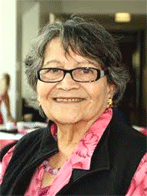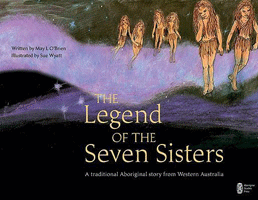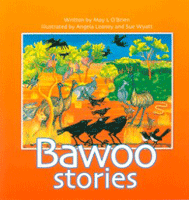May O’Brien – February 21 2016
International Mother Language Day – February 21 2016
 May is an Australian educator and author. Born in Laverton, Western Australia, at the age of five she was removed to the Mount Margaret Aboriginal Mission. In 1953, she received her Teacher’s Certificate at Claremont Teachers College. She was the first known Aboriginal woman in Western Australia to graduate from a tertiary institution. After teaching for 25 years May moved into education policy, working for the Western Australian Ministry of Education and the Aboriginal Education Branch. She was awarded the British Empire Medal in 1977 for her work in Aboriginal education. For this she was also awarded the John Curtin Medal. In 1980 May was a delegate for Australia at the United Nations Conference on Women. Her other books include Badudu Stories, illustrated by Angela Leaney, true stories about what it’s like for an Aboriginal child to move from a remote community college to a mainstream school, written from the child’s perspective.
May is an Australian educator and author. Born in Laverton, Western Australia, at the age of five she was removed to the Mount Margaret Aboriginal Mission. In 1953, she received her Teacher’s Certificate at Claremont Teachers College. She was the first known Aboriginal woman in Western Australia to graduate from a tertiary institution. After teaching for 25 years May moved into education policy, working for the Western Australian Ministry of Education and the Aboriginal Education Branch. She was awarded the British Empire Medal in 1977 for her work in Aboriginal education. For this she was also awarded the John Curtin Medal. In 1980 May was a delegate for Australia at the United Nations Conference on Women. Her other books include Badudu Stories, illustrated by Angela Leaney, true stories about what it’s like for an Aboriginal child to move from a remote community college to a mainstream school, written from the child’s perspective.
 The Legend of the Seven Sisters – Illustrated by Sue Wyatt
The Legend of the Seven Sisters – Illustrated by Sue Wyatt
Aboriginal Studies Press, 2009; ISBN 9780855756994
6-10 years
A wonderful retelling of the Western Australian Wongutha people’s story of how the Seven Sisters (Pleiades) came to be. It tells of the beautiful sisters who used to visit the earth and wander the land and explains why they appear in their position in the night sky. This is a great way to introduce traditional Indigenous beliefs, dreaming stories and language to children.
 Bawoo Stories – Illustrated by Sue Wyatt & Angela Leaney
Bawoo Stories – Illustrated by Sue Wyatt & Angela Leaney
Fremantle Press, 2008; ISBN 9781921361159
7 – 12 years
Four wonderful traditional stories of the Wongutha people are collected together here for the first time: Barn Barn Barlala, The Kangaroos Who Wanted to be People, How Crows Became Black and Why the Emu Can’t Fly. First published as individual titles in 1992, these stories were ground-breaking publications, presenting traditional Indigenous stories in a bi-lingual text. Updated with a vibrant new design, the stories are still as fresh and appealing as ever. The collected work contains a map, explanatory note and a simple pronunciation guide for the Wongutha words used in the text.
